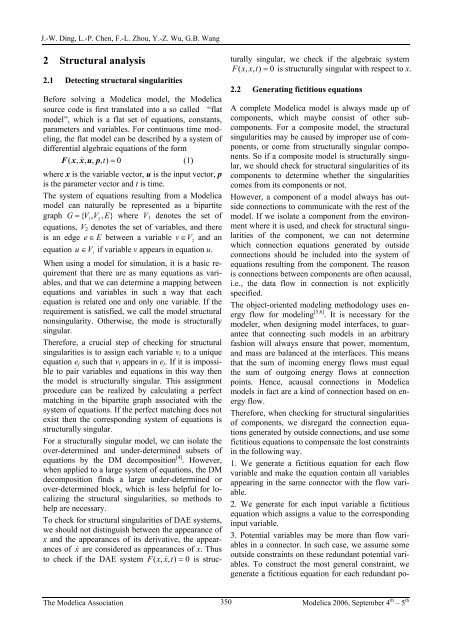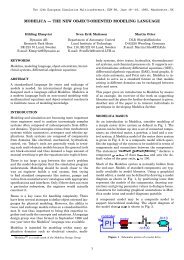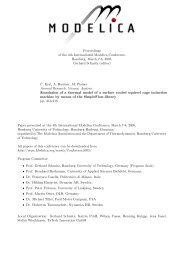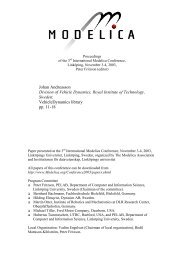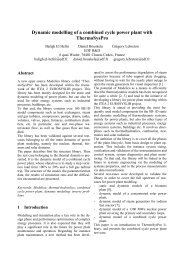Proceedings of the 5th International Modelica Conference Volume 2
Proceedings of the 5th International Modelica Conference Volume 2
Proceedings of the 5th International Modelica Conference Volume 2
Create successful ePaper yourself
Turn your PDF publications into a flip-book with our unique Google optimized e-Paper software.
J.-W. Ding, L.-P. Chen, F.-L. Zhou, Y.-Z. Wu, G.B. Wang<br />
2 Structural analysis<br />
2.1 Detecting structural singularities<br />
Before solving a <strong>Modelica</strong> model, <strong>the</strong> <strong>Modelica</strong><br />
source code is first translated into a so called “flat<br />
model”, which is a flat set <strong>of</strong> equations, constants,<br />
parameters and variables. For continuous time modeling,<br />
<strong>the</strong> flat model can be described by a system <strong>of</strong><br />
differential algebraic equations <strong>of</strong> <strong>the</strong> form<br />
F ( x,<br />
x&<br />
, u,<br />
p,<br />
t)<br />
= 0<br />
(1)<br />
where x is <strong>the</strong> variable vector, u is <strong>the</strong> input vector, p<br />
is <strong>the</strong> parameter vector and t is time.<br />
The system <strong>of</strong> equations resulting from a <strong>Modelica</strong><br />
model can naturally be represented as a bipartite<br />
graph G = { V1,<br />
V2,<br />
E}<br />
where V1 denotes <strong>the</strong> set <strong>of</strong><br />
equations, V2 denotes <strong>the</strong> set <strong>of</strong> variables, and <strong>the</strong>re<br />
is an edge e ∈ E between a variable v ∈ V2<br />
and an<br />
equation u ∈ V1<br />
if variable v appears in equation u.<br />
When using a model for simulation, it is a basic requirement<br />
that <strong>the</strong>re are as many equations as variables,<br />
and that we can determine a mapping between<br />
equations and variables in such a way that each<br />
equation is related one and only one variable. If <strong>the</strong><br />
requirement is satisfied, we call <strong>the</strong> model structural<br />
nonsingularity. O<strong>the</strong>rwise, <strong>the</strong> mode is structurally<br />
singular.<br />
Therefore, a crucial step <strong>of</strong> checking for structural<br />
singularities is to assign each variable vi to a unique<br />
equation ej such that vi appears in ej. If it is impossible<br />
to pair variables and equations in this way <strong>the</strong>n<br />
<strong>the</strong> model is structurally singular. This assignment<br />
procedure can be realized by calculating a perfect<br />
matching in <strong>the</strong> bipartite graph associated with <strong>the</strong><br />
system <strong>of</strong> equations. If <strong>the</strong> perfect matching does not<br />
exist <strong>the</strong>n <strong>the</strong> corresponding system <strong>of</strong> equations is<br />
structurally singular.<br />
For a structurally singular model, we can isolate <strong>the</strong><br />
over-determined and under-determined subsets <strong>of</strong><br />
equations by <strong>the</strong> DM decomposition [4] . However,<br />
when applied to a large system <strong>of</strong> equations, <strong>the</strong> DM<br />
decomposition finds a large under-determined or<br />
over-determined block, which is less helpful for localizing<br />
<strong>the</strong> structural singularities, so methods to<br />
help are necessary.<br />
To check for structural singularities <strong>of</strong> DAE systems,<br />
we should not distinguish between <strong>the</strong> appearance <strong>of</strong><br />
x and <strong>the</strong> appearances <strong>of</strong> its derivative, <strong>the</strong> appear-<br />
ances <strong>of</strong> x& are considered as appearances <strong>of</strong> x. Thus<br />
to check if <strong>the</strong> DAE system F( x,<br />
x&<br />
, t)<br />
= 0 is struc-<br />
turally singular, we check if <strong>the</strong> algebraic system<br />
F ( x,<br />
x,<br />
t)<br />
= 0 is structurally singular with respect to x.<br />
2.2 Generating fictitious equations<br />
A complete <strong>Modelica</strong> model is always made up <strong>of</strong><br />
components, which maybe consist <strong>of</strong> o<strong>the</strong>r subcomponents.<br />
For a composite model, <strong>the</strong> structural<br />
singularities may be caused by improper use <strong>of</strong> components,<br />
or come from structurally singular components.<br />
So if a composite model is structurally singular,<br />
we should check for structural singularities <strong>of</strong> its<br />
components to determine whe<strong>the</strong>r <strong>the</strong> singularities<br />
comes from its components or not.<br />
However, a component <strong>of</strong> a model always has outside<br />
connections to communicate with <strong>the</strong> rest <strong>of</strong> <strong>the</strong><br />
model. If we isolate a component from <strong>the</strong> environment<br />
where it is used, and check for structural singularities<br />
<strong>of</strong> <strong>the</strong> component, we can not determine<br />
which connection equations generated by outside<br />
connections should be included into <strong>the</strong> system <strong>of</strong><br />
equations resulting from <strong>the</strong> component. The reason<br />
is connections between components are <strong>of</strong>ten acausal,<br />
i.e., <strong>the</strong> data flow in connection is not explicitly<br />
specified.<br />
The object-oriented modeling methodology uses energy<br />
flow for modeling [5,6] . It is necessary for <strong>the</strong><br />
modeler, when designing model interfaces, to guarantee<br />
that connecting such models in an arbitrary<br />
fashion will always ensure that power, momentum,<br />
and mass are balanced at <strong>the</strong> interfaces. This means<br />
that <strong>the</strong> sum <strong>of</strong> incoming energy flows must equal<br />
<strong>the</strong> sum <strong>of</strong> outgoing energy flows at connection<br />
points. Hence, acausal connections in <strong>Modelica</strong><br />
models in fact are a kind <strong>of</strong> connection based on energy<br />
flow.<br />
Therefore, when checking for structural singularities<br />
<strong>of</strong> components, we disregard <strong>the</strong> connection equations<br />
generated by outside connections, and use some<br />
fictitious equations to compensate <strong>the</strong> lost constraints<br />
in <strong>the</strong> following way.<br />
1. We generate a fictitious equation for each flow<br />
variable and make <strong>the</strong> equation contain all variables<br />
appearing in <strong>the</strong> same connector with <strong>the</strong> flow variable.<br />
2. We generate for each input variable a fictitious<br />
equation which assigns a value to <strong>the</strong> corresponding<br />
input variable.<br />
3. Potential variables may be more than flow variables<br />
in a connector. In such case, we assume some<br />
outside constraints on <strong>the</strong>se redundant potential variables.<br />
To construct <strong>the</strong> most general constraint, we<br />
generate a fictitious equation for each redundant po-<br />
The <strong>Modelica</strong> Association <strong>Modelica</strong> 2006, September 4 th – 5 th<br />
350


